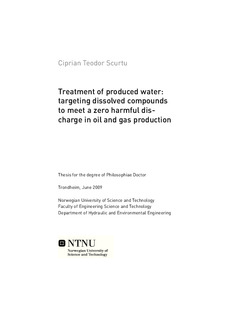| dc.contributor.author | Scurtu, Ciprian Teodor | nb_NO |
| dc.date.accessioned | 2014-12-19T12:31:12Z | |
| dc.date.available | 2014-12-19T12:31:12Z | |
| dc.date.created | 2009-07-06 | nb_NO |
| dc.date.issued | 2009 | nb_NO |
| dc.identifier | 226817 | nb_NO |
| dc.identifier.isbn | 978-82-471-1439-1 (printed ver.) | nb_NO |
| dc.identifier.isbn | 978-82-471-1440-7 (electronic ver.) | nb_NO |
| dc.identifier.uri | http://hdl.handle.net/11250/242090 | |
| dc.description.abstract | High amounts of dissolved compounds are discharged into the sea with the producedwater generated from the offshore oil and gas platforms. Some of these compounds are toxic to the environment, having important contributions to the environmental impact factors (EIF) calculated for produced water discharges. No performance standards currently exist for the removal of dissolved compounds from produced water. However, the overall goals for oil, natural components and chemicals in produced water require reducing the input into the sea of oil and other substances resulting from produced water from offshore installations. The ultimate aim is to eliminate pollution from those sources and ensure that effort is made to give priority to actions related to the most harmful components of produced water.
The goal of this study is to acquire further knowledge and technology to attain the “Zero Harmful Discharge” policy initiated by the Norwegian authorities. The ambition is to study a treatment method to meet the requirements of the future performance standards for the removal of harmful dissolved organic compounds.
The dissolved compounds can be removed by physical/chemical methods such as stripping, oxidation, membrane technology, extraction, sorption as well as biological treatment. Required process size is a key factor limiting the application of several of the alternatives described above, especially if very low effluent concentrations must be achieved. Handling of the “waste” stream that could be spent sorption media, off-gas that requires further treatment or concentrate from a membrane process, is another common limitation.
The scope of this study was to investigate the feasibility of a treatment concept that combines selective in-line sorption of selected dissolved compounds (BTX) coupled with biological regeneration of the spent media in a fluidized bed reactor (FBR). The research work was focused on the following issues: selective sorption of dissolved aromatic compounds but not of organic acids from produced water, assessment of the efficiency of the bioregeneration process and feasibility of the treatment concept based on sorption and biological regeneration in a continuous process. BTEX were selected to be used in the tests because they are found by far in the highest concentration in produced water among the dissolved aromatic compounds, while acetic acid was chosen for the same reason as the representative of the organic acids group. In the first instance, the sorption properties of several different types of sorption media were investigated. Focus was made on sorbents, which seemed to be promising for this application based on reports found during the literature review. This included also an assessment of sorption kinetics of the selected media. After identifying the most appropriate sorbent, laboratory experiments were conducted to study the biodegradation of the sorbed compounds by the microorganisms grown on the sorbent granules. Finally, a laboratory-scale experimental setup was built and operated in order to study and determine the feasibility and potentials of the treatment concept. Results indicated that selective sorption of BTX compounds from wastewater was achieved by using an organoclay. This sorbent showed good affinity for BTX compounds and at the same time retained only to a low extent acetic acid from wastewater. Off-line biological regeneration of the organoclay was shown to be feasible under the studied conditions. Operating conditions depended on wastewater quality, therefore FBR operation had to be tuned first to sorb the entire amount of BTX compounds from produced water and then completely biodegrade the previously sorbed compounds in order for the organoclay bed to recover its entire sorption capacity. Longtime off-line bioregeneration experiments indicated that the organoclay bed lost a part of its sorption capacity over time. Possible causes for this phenomenon could be: accumulation of organic compounds and minerals, particle attrition, desorption and biodegradation of the tailoring agent (dimethyl dihydrogenated ammonium chloride). | nb_NO |
| dc.language | eng | nb_NO |
| dc.publisher | Norges teknisk-naturvitenskapelige universitet, Fakultet for ingeniørvitenskap og teknologi, Institutt for vann- og miljøteknikk | nb_NO |
| dc.relation.ispartofseries | Doktoravhandlinger ved NTNU, 1503-8181; 2009:35 | nb_NO |
| dc.title | Treatment of produced water:targeting dissolved compounds to meet a zero harmful discharge in oil and gas production | nb_NO |
| dc.type | Doctoral thesis | nb_NO |
| dc.contributor.department | Norges teknisk-naturvitenskapelige universitet, Fakultet for ingeniørvitenskap og teknologi, Institutt for vann- og miljøteknikk | nb_NO |
| dc.description.degree | PhD i vann- og miljøteknikk | nb_NO |
| dc.description.degree | PhD in Hydraulic and Environmental Engineering | en_GB |
